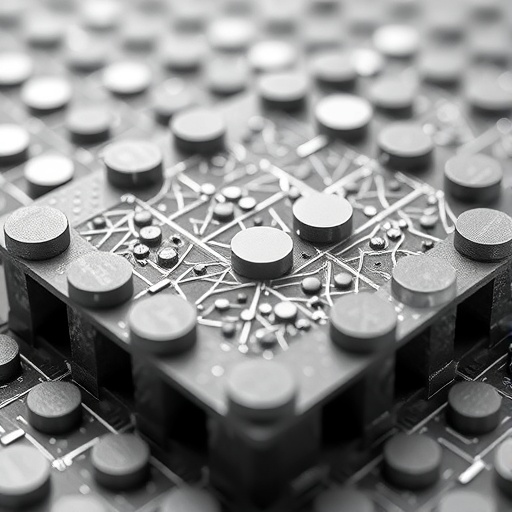Direct ink writing (DIW) has increasingly become a pivotal technique in the realm of additive manufacturing, particularly for the production of flexible electronics. This innovative approach enables the creation of intricate geometries, allowing for the unprecedented design and implementation of devices that adapt to various applications. Amidst the surging demand for flexible electronic components, the advantages of DIW stand out—especially its capability to produce flexible sensors that can conform to complex shapes and surfaces, making them ideal for varied environments and utilitarian functions.
However, the novel filament deposition methods employed in DIW introduce challenges, particularly concerning the anisotropic characteristics of the resulting surface textures. This anisotropy, often characterized by directional discrepancies in the texture of deposited materials, can significantly impact the electrical and mechanical performance of the printed devices. Researchers have posited that these anisotropic surface morphologies can influence the way flexible sensors respond to external stimuli, and understanding this relationship could be crucial for optimizing sensor design and functionality.
To advance performance-enhanced flexible sensor architectures, systematic investigations into the interplay between surface topology and electronic performance must be undertaken. By exploring how the textures produced during the DIW process affect the behavior of electrical pathways and overall device stability, researchers can develop strategies to design sensors that not only perform better but also offer increased reliability and longevity.
The intricacies of the DIW process itself are a fundamental component of this discussion. The method involves the deposition of viscous ink through a nozzle, which then solidifies to form structures layer by layer. However, as the ink is extruded, the shear forces and other processing conditions can lead to inconsistencies in the material flow, culminating in surfaces that vary in texture from one direction to another. This variation is particularly pertinent when considering the orientation of conductive paths within electronic devices, which are critical for ensuring optimal performance.
Moreover, understanding how these anisotropic features manifest during the DIW process is crucial for engineering applications where uniform electronic response is desired. For instance, in flexible sensors used in wearable technology, the performance may vary significantly when exposed to bending or twisting actions. The directional integrity of the conductive paths determines how well the sensor can react to physical changes, and any inconsistencies originating from the DIW process can lead to unpredictable readings or performance failure.
Research efforts are essential to bridge the gap between the physical manifestation of these anisotropic surfaces and the underlying electronic characteristics. By employing advanced analytical techniques such as atomic force microscopy (AFM) and scanning electron microscopy (SEM), scientists can elucidate the fine details of surface morphology. These tools allow researchers to visualize and quantify the texture variations, thereby correlating these features with device performance metrics such as sensitivity, response time, and durability.
In pursuit of enhanced flexible sensor technologies, it is also vital to consider material choices in conjunction with the DIW process. The selection of inks, which may include polymers filled with conductive nanoparticles, plays a significant role in determining the mechanical and electrical attributes of the final product. Different formulations can yield varying levels of conductivity and flexibility, impacting the sensor’s performance under varied environmental conditions. Consequently, optimizing material compositions in tandem with the filament deposition process can lead to more robust and sensitive flexible sensors.
Moreover, the optimization process is iterative; findings from performance studies inform adjustments in both material selection and DIW techniques. As researchers examine the performance of various sensor designs featuring different topographical features, they can reverse-engineer these insights to refine their approaches, ultimately steering the design towards enhancements that marry both texture and functionality.
Collaboration between inter-disciplinary teams is increasingly evident in efforts to tackle these challenges. The interplay of materials scientists, mechanical engineers, and electronics experts is crucial for advancing the field of flexible electronics. By pooling expertise, teams can address complexities inherent in the DIW process while developing innovative solutions that enhance performance through improved understanding of the manifold effects of anisotropic textures.
As the landscape for flexible electronics continues to evolve, the implications of these findings extend beyond mere improvement of sensor technologies. They encompass broader applications such as smart textiles, healthcare monitoring systems, and even integration into consumer electronics that can adapt to user preferences and environmental changes. Advancements initiated through a thorough understanding of the DIW process herald a new era of electronics that are not only more efficient but also more intuitive and user-friendly.
The pixelated world of electronics is on the brink of transformation due to the capabilities of DIW. By deepening our understanding of how deposition techniques influence surface characteristics and, subsequently, electronic performance, researchers can lay the groundwork for the next generation of smart technologies. As investigations continue to reveal the intricate relationships between morphology and performance, the potential of flexible electronics—capable of seamlessly integrating into daily life—looks remarkably promising.
In conclusion, the advancements in direct ink writing represent a confluence of science and engineering that holds considerable promise for the future of electronic devices. Unlocking the secrets of anisotropic surface textures in this context will not only yield superior flexible sensors but could also catalyze an ongoing revolution in how electronic interfaces are conceived, designed, and utilized. The journey from raw material to complex, functional device becomes an increasingly intricate dance, where every detail counts in the pursuit of excellence in flexible electronics.
Subject of Research: Direct Ink Writing for Flexible Electronics
Article Title: Exploring the Impact of Surface Morphology on Flexible Sensor Performance
News Publication Date: [Not specified]
Web References: [Not specified]
References: [Not specified]
Image Credits: [Not specified]
Keywords
Additive manufacturing, direct ink writing, flexible electronics, anisotropic textures, surface morphology, sensor performance, advanced materials, electronic devices.
Tags: additive manufacturing techniquesadvanced flexible sensor architecturesanisotropic surface characteristicschallenges in filament deposition methodsDirect ink writing nanogeneratorsdirectional discrepancies in material textureselectrical performance in printed devicesflexible electronics manufacturingflexible sensor design improvementspiezoelectric performance optimizationsurface topology influence on sensorstextured structures in electronics





